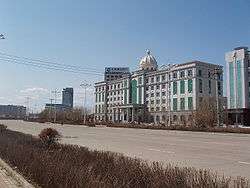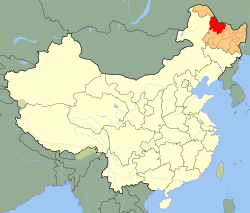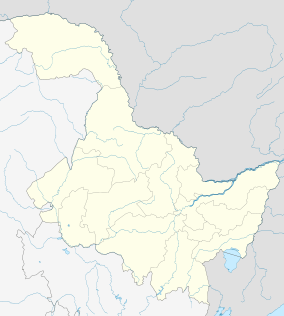Heihe
Heihe (Chinese: 黑河; pinyin: Hēihé; "Black River") is a prefecture-level city of northern Heilongjiang province, China, located on the Russian border, on the south bank of the Heilong Jiang, across the river from Blagoveshchensk. Heihe has an urban population of about 211,313, while the total population of the prefecture-level city is 1,673,893.[1] In 2015, Heihe had a GDP of RMB 44.78 billion. [2]
Heihe marks the northeast terminus of the Heihe–Tengchong Line, which is sometimes used to divide China into east and west.
History
.jpg)
Heihe, formerly Aihui or Aigun, is among one of the five oldest cities in Heilongjiang, along with Tsitsihar, Yilan, Acheng and Hulan. Human beings started to settle in Heihe region as early as the Paleolithic Age.[3] Later it became home to local tribes. During the Qing Dynasty, Heihe was the first place troops sent to Heilongjiang were stationed. The predecessor of today's Heihe was the town established by the indigenous Ducher people of the Amur Valley in the mid 1650s.[3] It was established some 30 km (19 mi) south of the modern city site[4] (in today's Aihui District) and was known as Aigun, Heilongjiang, or Saghalien Ula. (The two last names both mean "the Black Dragon River" - the name for the Amur River in Chinese and Manchu, respectively).
After the Ducher were evacuated by the Qing to the Sungari or Hurka in the 1650s, the Ducher town was probably vacated. However, in 1683-85 the Manchus re-used the site as a base for their campaign against the Russian fort of Albazin.[5] Aigun was the capital (the seat of the military governor) of Heilongjiang from 1683 to 1690, before the capital was moved to Nenjiang (Mergen).[6] After the capture of Albazin in 1685 or 1686, the Qing governor relocated the town to a new site on the right (southwestern) bank of the Amur, about 3 miles downstream from the original.[7][8] The new site occupied the location of the former village of the Daurian chief named Tolga.[7] The city became known primarily under its Manchu name Saghalien Ula hoton (Manchu: 萨哈连乌拉) and Chinese name Heilongjiang Cheng (黑龍江城), which both mean "Black River City".[9] Later the governor office was transferred to Qiqihar. However, Aigun remained the seat of the Deputy Lieutenant-General (Fu dutong), responsible for a large district covering much of the Amur Valley within the province of Heilongjiang as it existed in those days.[6]
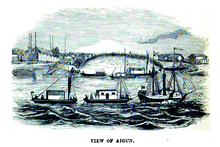
Aigun was visited around 1709 as a part of a nationwide Sino-French cartographic program by the Jesuits Jean-Baptiste Régis, Pierre Jartoux, and Xavier Ehrenbert Fridelli,[10] who found it a stronghold, serving as the base of Manchus controlling the Amur River basin. The Aigun Treaty was concluded at Aigun in 1858. According to this treaty, the left bank of the Amur River was conceded to Czarist Russia.
After Xinhai Revolution, Aigun became the county seat of the newly created Aigun County by the Republic of China. On November 15, 1980, Heihe City was established, administering two county-level cities and three counties including Beian, Wudalianchi, Nenjiang, Sunwu and Sunke. Aihui County was abolished, being merged into the Heihe City.[11]
Geography
Heihe is located at the South bank of the Amur, opposite to the city of Blagoveshchensk in Russia's Amur Oblast. Its jurisdictional area stretches for 54,390 km2 (21,000 sq mi), which spans from 124° 45' to 129° 18' E longitude and 47° 42' to 51° 03' N latitude. Domestically, Heihe City borders Da Hinggan Ling Prefecture to the north, Yichun to the southeast, Suihua to the south, Qiqihar to the southwest, and Hulunbuir (Inner Mongolia) to the west. The Amur has formed the Sino-Russian border since the 1858 Aigun Treaty and 1860 Treaty of Peking. The area north of the Amur had previously belonged to Imperial China.
Climate
Heihe experiences a monsoon-influenced humid continental climate (Köppen climate classification Dwb), but Dwa in the south of the prefecture, with long, bitterly cold, windy, but dry winters due to the influence of the Siberian high, and warm, wet summers, due to the East Asian monsoon. Based on data from 1971–2000, the monthly daily mean temperature in January, the coldest month, is −23.2 °C (−9.8 °F), and July, the warmest month, averages 20.8 °C (69.4 °F), with an average annual temperature +0.38 °C (32.7 °F). Close to two-thirds of the annual precipitation falls in the months of June to August. Extreme temperatures have ranged from −44.5 °C (−48 °F) to 37.2 °C (99 °F).
| Climate data for Heihe | |||||||||||||
|---|---|---|---|---|---|---|---|---|---|---|---|---|---|
| Month | Jan | Feb | Mar | Apr | May | Jun | Jul | Aug | Sep | Oct | Nov | Dec | Year |
| Record high °C (°F) | −0.5 (31.1) |
7.1 (44.8) |
20.4 (68.7) |
26.1 (79) |
35.1 (95.2) |
35.6 (96.1) |
37.2 (99) |
33.2 (91.8) |
31.1 (88) |
24.2 (75.6) |
12.5 (54.5) |
1.1 (34) |
37.2 (99) |
| Average high °C (°F) | −16.6 (2.1) |
−10.1 (13.8) |
−0.9 (30.4) |
10.4 (50.7) |
19.2 (66.6) |
25.1 (77.2) |
27.1 (80.8) |
24.7 (76.5) |
18.7 (65.7) |
8.6 (47.5) |
−5.1 (22.8) |
−15 (5) |
7.2 (44.9) |
| Daily mean °C (°F) | −23.2 (−9.8) |
−18 (0) |
−8.3 (17.1) |
3.5 (38.3) |
11.9 (53.4) |
18.2 (64.8) |
20.8 (69.4) |
18.3 (64.9) |
11.6 (52.9) |
1.9 (35.4) |
−11.2 (11.8) |
−20.9 (−5.6) |
0.38 (32.72) |
| Average low °C (°F) | −27.4 (−17.3) |
−22.5 (−8.5) |
−13 (9) |
−1.7 (28.9) |
6.1 (43) |
13.2 (55.8) |
16.8 (62.2) |
14.6 (58.3) |
7.3 (45.1) |
−2 (28) |
−14.6 (5.7) |
−24.6 (−12.3) |
−4 (24.8) |
| Record low °C (°F) | −44.5 (−48.1) |
−40.9 (−41.6) |
−32.8 (−27) |
−19.1 (−2.4) |
−8.4 (16.9) |
1.7 (35.1) |
7.9 (46.2) |
4.0 (39.2) |
−5.3 (22.5) |
−19.1 (−2.4) |
−32.8 (−27) |
−38.9 (−38) |
−44.5 (−48.1) |
| Average precipitation mm (inches) | 4.1 (0.161) |
3.0 (0.118) |
5.7 (0.224) |
25.2 (0.992) |
41.1 (1.618) |
86.0 (3.386) |
131.0 (5.157) |
121.4 (4.78) |
65.4 (2.575) |
23.5 (0.925) |
9.1 (0.358) |
6.3 (0.248) |
521.8 (20.542) |
| Average precipitation days (≥ 0.1 mm) | 7.1 | 4.3 | 4.8 | 8.0 | 10.4 | 13.4 | 14.0 | 13.8 | 11.8 | 6.8 | 6.9 | 8.7 | 130.0 |
| Average snowy days | 11 | 7 | 8 | 6 | 1 | 0 | 0 | 0 | 0 | 5 | 10 | 12 | 60 |
| Average relative humidity (%) | 73 | 68 | 62 | 55 | 55 | 69 | 76 | 78 | 72 | 61 | 67 | 74 | 67.5 |
| Mean monthly sunshine hours | 139.5 | 194.9 | 226.3 | 222.0 | 251.1 | 255.0 | 226.3 | 226.3 | 168.0 | 189.1 | 156.0 | 124.0 | 2,378.5 |
| Source #1: Weather China (Daily mean temp, Precip, Precip days, Records 1971–2000) [12] | |||||||||||||
| Source #2: Blagoveshchensk (Average high and low, Humidity, Snow days 1981–2010, Sun 1961–1990)[13][14] | |||||||||||||
Administrative divisions
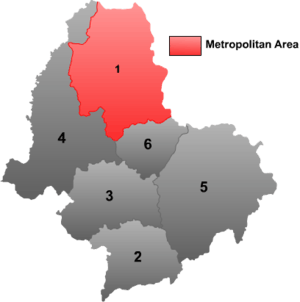 | ||||||
| # | Name | Hanzi | Hanyu Pinyin | Population (2010 est.) | Area (km²) | Density (/km²) |
|---|---|---|---|---|---|---|
| 1 | Aihui District | 爱辉区 | Àihuī Qū | 211,313 | 13,993 | 15 |
| 2 | Bei'an City | 北安市 | Běi'ān Shì | 436,444 | 6,313 | 69 |
| 3 | Wudalianchi City | 五大连池市 | Wǔdàliánchí Shì | 326,390 | 9,800 | 33 |
| 4 | Nenjiang County | 嫩江县 | Nènjiāng Xiàn | 495,519 | 15,360 | 32 |
| 5 | Xunke County | 逊克县 | Xùnkè Xiàn | 101,411 | 17,020 | 6 |
| 6 | Sunwu County | 孙吴县 | Sūnwú Xiàn | 102,821 | 4,454 | 23 |
Transportation
_shore.jpg)
The transportation to and from Heihe is as follows:
- Highways
- China National Highway 202: Heihe–Dalian via Harbin, Jilin City and Shenyang
- Provincial highways: Heihe–Mohe, etc.
- Railway (China Railways): Heihe–Bei'an to Harbin, Qiqihar and Daqing
- Waterway
- Transportation between Blagoveshchensk and Heihe is by boat in the summer and by bus over the frozen river in the winter; when the ice is too thin to carry buses, the route is operated by hovercrafts.
- Air: Heihe Aihui Airport
Energy
West of Heihe, there is an HVDC back-to-back station for realizing an interconnection between the power grids of Russia and China with 750 MW transmission capacity.
Tourism
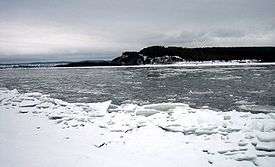
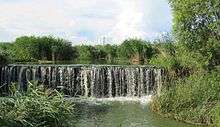
Heihe has plenty of natural tourism resources, including the Amur River and Wudalianchi Lake (五大连池) and Wudalianchi Volcanic Range (五大连池火山群), where people can take a trip to local volcanoes. The Old City of Aigun is a famous historical scenic spot, in which the Treaty of Aigun between China and Russia was signed in the 19th century.
Sport
Heihe University (黑河学院) has requested the Russian bandy club SKA Neftyanik to send a coach, offering a one-year contract.
Sister cities
-
 Blagoveshchensk, Amur Oblast, Russia
Blagoveshchensk, Amur Oblast, Russia -
 Krasnoyarsk, Krasnoyarsk Krai, Russia[15]
Krasnoyarsk, Krasnoyarsk Krai, Russia[15]
See also
References
- ↑ 黑河市2010年第六次全国人口普查主要数据公报
- ↑ Template:Cite: url
- 1 2 Амурская область: История НАРОДЫ АМУРСКОЙ ЗЕМЛИ (Amur Oblast: the History. The peoples of the Amur Land) (Russian)
- ↑ The Ancient City of Aigun
- ↑ Bruce Mancall, 'Russia and China: Their Diplomatic Relations to 1728, 1971, pages 115-127
- 1 2 Edmonds, Richard Louis (1985). Northern Frontiers of Qing China and Tokugawa Japan: A Comparative Study of Frontier Policy. University of Chicago, Department of Geography; Research Paper No. 213. pp. 115–117. ISBN 0-89065-118-3.
- 1 2 E.G.Ravenstein, The Russians on the Amur. London, 1861. text can be found on Google Books. Pages 18,48.
- ↑ The Jesuits (at du Halde, pp. 18-19), who visited the "new" Aigun ca. 1709, mentioned the old site on the left bank of the river (which they called Aykom), but said that it was 13 [[li (unit)|]li], i.e., some 8.3 km, upstream from the new site. They also claimed that Aykom was originally founded by the 15th-century Ming Yongle Emperor but abandoned within 20 years. Although Yongle's Amur expeditions are well known (see, e.g., Yishiha), there seem to be no corroboration in modern literature for the existence of a Yongle-era fort at the Old Aigun site.
- ↑ Jean-Baptiste Du Halde, Description géographique, historique, chronologique, politique, et physique de l'empire de la Chine et de la Tartarie chinoise, enrichie des cartes générales et particulieres de ces pays, de la carte générale et des cartes particulieres du Thibet, & de la Corée; & ornée d'un grand nombre de figures & de vignettes gravées en tailledouce, Vol. 4 (La Haye: H. Scheurleer, 1736). Pp. 18-19.
- ↑ Jean-Baptiste Du Halde, Description géographique, historique, chronologique, politique, et physique de l'empire de la Chine et de la Tartarie chinoise, enrichie des cartes générales et particulieres de ces pays, de la carte générale et des cartes particulieres du Thibet, & de la Corée; & ornée d'un grand nombre de figures & de vignettes gravées en tailledouce, Vol. 1 (La Haye: H. Scheurleer, 1736). (p. xxxviii in Vol. 1)
- ↑ 爱辉区概况 (Aihui District overview) (Chinese)
- ↑ 黑河 - 气象数据 -中国天气网 (in Chinese). Weather China. Retrieved 2012-07-12.
- ↑ "Климат Благовещенска". Pogoda.
- ↑ "Climatological Information for Blagovescensk, Russia". Hong Kong Observatory. Retrieved 2011-10-17.
- ↑ As of today, Krasnoyarsk City Administration has concluded protocols of intent and agreements on cooperation with the following foreign cities:
| Wikimedia Commons has media related to Heihe. |
